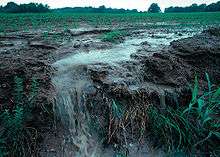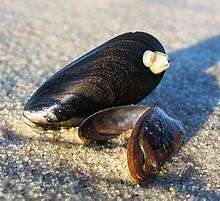Nutrient pollution

Nutrient pollution, a form of water pollution, refers to contamination by excessive inputs of nutrients. It is a primary cause of eutrophication of surface waters, in which excess nutrients, usually nitrogen or phosphorus, stimulate algal growth. Sources of nutrient pollution include surface runoff from farm fields and pastures, discharges from septic tanks and feedlots, and emissions from combustion. Excess nutrients have been summarized as potentially leading to:[1]
- Population effects: excess growth of algae (blooms);
- Community effects: species composition shifts (dominant taxa);
- Ecological effects:food web changes, light limitation;
- Biogeochemical effects: excess organic carbon (eutrophication); dissolved oxygen deficits (environmental hypoxia); toxin production;
- Human health effects: excess nitrate in drinking water (blue baby syndrome); disinfection by-products in drinking water.
In a 2011 United States Environmental Protection Agency report, the agency's Science Advisory Board succinctly stated: “Excess reactive nitrogen compounds in the environment are associated with many large-scale environmental concerns, including eutrophication of surface waters, toxic algae blooms, hypoxia, acid rain, nitrogen saturation in forests, and global warming.”[2]
Excess nutrients and TMDLs
The regulatory mechanism in the United States, a Total Maximum Daily Load (TMDL), prescribes the maximum amount of a pollutant (including nutrients) that a body of water can receive while still meeting U.S. Clean Water Act water quality standards. Specifically, Section 303 of the Clean Water Act requires each state to generate a TMDL report for each body of water impaired by pollutants. TMDL reports identify pollutant levels and strategies to accomplish pollutant reduction goals. EPA has described TMDLs as establishing a pollutant budget then allocating portions of the overall budget to the pollutant's sources.[3] For many coastal water bodies, the main pollutant issue is excess nutrients, also termed nutrient over-enrichment.[4] A TMDL can prescribe the minimum level of Dissolved Oxygen (DO) available in a body of water, which is directly related to nutrient levels. (See Aquatic Hypoxia.) In 2010, 18 percent of TMDLs nationwide were related to nutrient levels including organic enrichment/oxygen depletion, noxious plants, algal growth, and ammonia.[5] In Long Island Sound the TMDL development process enabled the Connecticut Department of Environmental Protection (CTDEP) and the New York State Department of Environmental Conservation (NYSDEC) to incorporate a 58.5 percent nitrogen reduction target into a regulatory and legal framework.[6]
Nutrient remediation

Innovative solutions have been conceived to deal with nutrient pollution in aquatic systems by altering or enhancing natural processes to shift nutrient effects away from detrimental ecological impacts. Nutrient remediation is a form of environmental remediation, but concerns only biologically active nutrients such as nitrogen and phosphorus. “Remediation” refers to the removal of pollution or contaminants, generally for the protection of human health. In environmental remediation nutrient removal technologies include biofiltration, which uses living material to capture and biologically degrade pollutants. Examples include green belts, riparian areas, natural and constructed wetlands, and treatment ponds. These areas most commonly capture anthropogenic discharges such as wastewater, stormwater runoff, or sewage treatment, for land reclamation after mining, refinery activity, or land development. Biofiltration utilizes biological assimilation to capture, absorb, and eventually incorporate the pollutants (including nutrients) into living tissue. Another form of nutrient removal is bioremediation, which uses microrganisms to remove pollutants. Bioremediation can occur on its own as natural attenuation or intrinsic bioremediation or can be encouraged by the addition of fertilizers, called biostimulation.
Nutrient bioextraction is the preferred term for bioremediation involving cultured plants and animals. Nutrient bioextraction or bioharvesting is the practice of farming and harvesting shellfish and seaweed for the purpose of removing nitrogen and other nutrients from natural water bodies.[7] It has been suggested that nitrogen removal by oyster reefs could generate net benefits for sources facing nitrogen emission restrictions, similar to other nutrient trading scenarios. Specifically, if oysters maintain nitrogen levels in estuaries below thresholds that would lead to the imposition of emission limits, oysters effectively save the sources the compliance costs they otherwise would incur.[8] Several studies have shown that oysters and mussels have the capacity to dramatically impact nitrogen levels in estuaries.[9][10][11]
History of nutrient policy in the United States
In 1998, a Policy for a National Nutrient Strategy was created with a focus on developing nutrient criteria. Between 2000-2010 criteria for Rivers/Streams, Lakes/Reservoirs, Estuaries, Wetlands, and guidance were completed, including "ecoregional" nutrient criteria in 14 ecoregions across the U.S. In 2004, the EPA Office of Science and Technology defined EPA’s expectations for numeric criteria for total nitrogen (TN), total phosphorus (TP), chlorophyll a(chl-a), and clarity, and established “mutually-agreed upon plans” for state criteria development. In 2007, EPA reiterated EPA’s expectations for numeric criteria and committed EPA to support state efforts.[12]
Nutrient trading
After the EPA had introduced watershed-based NPDES permitting in 2007,[13] interest in nutrient removal and achieving regional TMDLs led to the development of nutrient trading schemes. Nutrient trading is a type of water quality trading, a market-based policy instrument used to improve or maintain water quality. Water quality trading arose around 2005 and is based on the fact that different pollution sources in a watershed can face very different costs to control the same pollutant.[14] Water quality trading involves the voluntary exchange of pollution reduction credits from sources with low costs of pollution control to those with high costs of pollution control, and the same principles apply to nutrient water quality trading. The underlying principle is “polluter pays”, usually linked with a regulatory driver for participating is the trading program.[15]
A 2013 Forest Trends report summarized water quality trading programs and found three main types of funders: beneficiaries of watershed protection, polluters compensating for their impacts and ‘public good payers’ that may not directly benefit, but fund the pollution reduction credits on behalf of a government or NGO. As of 2013, payments were overwhelmingly initiated by public good payers like governments and NGOs.[16]:11
See also
- Agricultural wastewater treatment
- Biological assimilation
- Bioremediation
- Eutrophication
- Nonpoint source pollution
- Water quality
References
- ↑ EPA (December 13, 2011). "Water Quality Standards Academy" (PDF).
- ↑ EPA. "Reactive Nitrogen in the United States: An Analysis of Inputs, Flows, Consequences, and Management Options, A Report of the Science Advisory Board EPA-SAB-11-013" (PDF). Archived from the original (PDF) on February 19, 2013.
- ↑ "Total Maximum Daily Load (TMDLs) at Work: New York: Restoring the Long Island Sound While Saving Money". EPA. Retrieved June 14, 2013.
- ↑ Golen, Richard F. "Incorporating Shellfish Bed Restoration into a Nitrogen TMDL Implementation Plan" (PDF).
- ↑ EPA (December 13, 2011). "Water Quality Standards Academy" (PDF).
- ↑ "Total Maximum Daily Load (TMDLs) at Work: New York: Restoring the Long Island Sound While Saving Money". EPA. Retrieved June 14, 2013.
- ↑ NOAA (n.d.). "Nutrient Bioextraction Overview". Long Island Sound Study partnership.
- ↑ Kroeger, Timm (2012). "Dollars and Sense: Economic Benefits and Impacts from two Oyster Reef Restoration Projects in the Northern Gulf of Mexico" (PDF). The Nature Conservancy.
- ↑ Newell, R.I.E., Fisher, T.R., Holyoke, R.R., Cornwell, J.C. (2005). "Influence of eastern oysters on nitrogen and phosphorus regeneration in Chesapeake Bay, USA". In Dame, R., Olenin, S. The Comparative Roles of Suspension Feeders in Ecosystems, Vol. 47 (NATO Science Series IV: Earth and Environmental Sciences ed.). Netherlands: Springer. pp. 93–120.
- ↑ Grabowski,J.H., Petersen, C.H. (2007). Cuddington, K., Byers, J.E., Wilson, W.G., Hastings, A, ed. Restoring oyster reefs to recover ecosystem services (Ecosystem Engineers: Concepts, Theory and Applications ed.). Amsterdam: Elsevier-Academic Press. pp. 281–298.
- ↑ Rose JM, Tedesco M, Wikfors GH, Yarish C (2010). "International Workshop on Bioextractive Technologies for Nutrient Remediation Summary Report". US Dept Commerce, Northeast Fish Sci Cent Ref Doc. 10-19; 12 p. Available from: National Marine Fisheries Service, 166 Water Street, Woods Hole, MA 02543-1026.
- ↑ EPA Water Quality Standards Academy (December 13, 2011). "Presentation about EPA's National Nutrient Criteria" (PDF). EPA. p. 54.
- ↑ "Watershed-Based NPDES Permitting". EPA. 20 July 2007. Retrieved 20 February 2015.
- ↑ "EPA Water Quality Trading Webcast Seminar". EPA. December 14, 2005.
- ↑ Genevieve Bennett; Nathaniel Carroll; Katherine Hamilton. "Charting New Waters, State of Watershed Payments 2012". Forest Trends.
- ↑ Genevieve Bennett, Nathaniel Carroll, and Katherine Hamilton (2013). "Charting New Waters State of Watershed Payments 2012Figure 4b: Watershed Investments by Payer Type, Globally, Excluding China" (PDF). Forest Trends Association. p. 98. Retrieved 20 February 2015.
 This article incorporates public domain material from the Congressional Research Service document "Report for Congress: Agriculture: A Glossary of Terms, Programs, and Laws, 2005 Edition" by Jasper Womach.
This article incorporates public domain material from the Congressional Research Service document "Report for Congress: Agriculture: A Glossary of Terms, Programs, and Laws, 2005 Edition" by Jasper Womach.
- EPA. "Protecting Water Quality from Agricultural Runoff." March 2005. Document No. EPA 841-F-05-001. Fact sheet.
External links
- Environmental Impacts and Benefits of Manure focuses on phosphorus and water quality. Part of the manure nutrient management section of the Livestock and Poultry Environmental Learning Center.